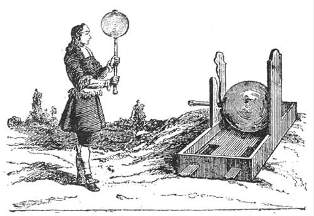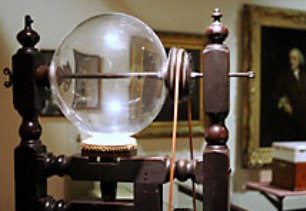Electrostatic machine opens new properties of electricity
In 1650, the well-known inventor of the air pump Magdeburg's Mayor Mayor Otto von Guericke (1602-1686) made a ball of sulfur "the size of a child's head," and planted it on an iron axis, mounted on a wooden tripod. With the help of the handle, the ball could rotate and rub with the palms of his hands or a piece of cloth pressed against the ball with his hand. It was the first simple electrostatic machine.
Guericke managed to notice the weak glow of the electrified ball in the dark and, most importantly, for the first time to find that the fluffs attracted by the ball later repel from it - this phenomenon neither Gerike nor many of his contemporaries could explain for a long time. From the letter of the famous German scientist GV Leibniz, (1646-1716), Gerike (March 1672), it is known that Leibniz, using his car, observed an electric spark - this is the first mention of this mysterious phenomenon.
During the first half of the XVIII century. The electrostatic machine has undergone a number of improvements: the sphere of sulfur has been replaced by a glass one, since the glass is more intensively electrified, and later instead of balls or cylinders (which were more difficult to produce and often exploded when heated), glass discs were used. For rubbing, leather pads pressed against the glass by springs were used. Later, to strengthen the electrification, the pads became covered with amalgam.

An important new element in the design of the machine was a conductor (1744) - a metal tube suspended on silk threads, and later mounted on insulating supports. The conductor served as a reservoir for collecting electric charges formed during friction. After the invention of the Leyden jar, they were also installed next to the machine.
In the 60's. XVIII century. The electrostatic machine has acquired the basic modern features. Very original, simple and reliable electrostatic machines were described in the work of the well-known Russian scientist encyclopaedist Andrei Timofeevich Bolotov (1738-1833). "Brief and experience-based remarks about electricity and the ability of electric machinas to help from various diseases" (St. Petersburg, 1803). ). They were even created room "folding" and "road" machines with a glass bowl diameter of 20 cm.
In an effort to get the most effect, some inventors built machines of enormous size: for example, in London an electrostatic machine with a disk diameter of 2 m 27 cm is stored, and its rotation was carried out by a steam engine (1849).
A variety of experiments with electrostatic machines and advances in the field of natural science caused considerable interest in electric phenomena to magnetic phenomena and led to the discovery of previously unknown facts. Two kinds of electricity were discovered and the laws of their interaction were revealed, and the "speed of electricity transmission" was established.

New electrical devices are being created, which made it possible to receive and store electricity in large quantities, and to measure its intensity. The study of the phenomena of atmospheric electricity begins, the first theories of electrical phenomena are being developed.
A significant step in studying the properties of electric charges was the study of a member of the English Royal Society Stefan Gray (1670-1736) and a member of the Paris Academy of Sciences Charles Francois Dufe (1698-1739 gg.).
As a result of numerous experiments, S. Gray established that "the electric ability of a glass tube to attract light bodies can be transferred to other bodies," and show (1729) that bodies, depending on their relationship to electricity, can be divided into two groups: conductors (For example, metal thread, wire) and non-conductors (for example, silk thread).
Continuing the experiments of S. Gray, Sh. F. Dufet (in 1733-1737) discovered two kinds of electricity - "glass", "resin" and their peculiarity to repel similar charges and attract the opposite. Dufet also created a prototype of an electroscope in the form of two suspended filaments diverging during their electrification.
Veselovsky O. N. Shneberg A. Ya "Essays on the history of electrical engineering"

You can also support shram.kiev.ua, press:
It will not be superfluous for your friends to learn this information, share their article with them!

Comments
When commenting on, remember that the content and tone of your message can hurt the feelings of real people, show respect and tolerance to your interlocutors even if you do not share their opinion, your behavior in the conditions of freedom of expression and anonymity provided by the Internet, changes Not only virtual, but also the real world. All comments are hidden from the index, spam is controlled.